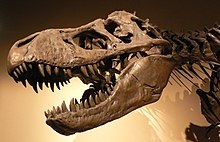|
|
| |
|
|
| |
|
|
|
|
| |
 |
| Tyrannosaurus rex. |
Fossils
A fossil is the remains or trace of an ancient living
thing.
Fossils of animals, plants or protists occur in
sedimentary rock.
In a typical fossil, the body form is retained, but the
original molecules that made up the body have been
replaced by some inorganic material, such as calcium
carbonate (CaCO3) or silica (SiO2). The fossil feels
like, and is, made of rock. It has been mineralised or
petrified (literally, turned into rock).
A fossil may also be an imprint or impression of a
living thing remaining in the fossilised mud of a
long-gone age.
Some organisms fossilise well, others do not. The most
common fossils are those left behind by organisms that
produce hard materials. The hard, calcitic shells of
molluscs (such as clams and snails) and of now-rare
brachiopods (also known as lampshells) are examples.
These sea-dwelling shellfish have produced many
fossiliferous (that is, fossil-bearing) chalky layers of
limestone in the earth.
Soft-bodied organisms can fossilise in special
circumstances: the Ediacaran biota is a good example.
The best-known fossils for the general public are those
of the giant, prehistoric dinosaurs. The fossilized
bones and fossilized tracks of these huge, ancient
reptiles can be seen in many museums of natural history
and earth science.
The study of fossils by geologists and biologists is
known as paleontology. If the study puts living things
in their ecological context it is called paleobiology. |
|
Places of special
preservation
There are some sites where fossils have been found with
remarkable details, or in large numbers.
Palaeontologists call these sites by the German term
Lagerstätten. The La Brea tar pits in Los Angeles is
such a place. So are the Solnhofen limestone quarries in
Bavaria. |
|
Types of fossils
Microscopic or very tiny fossils are called
"microfossils"; while larger, macroscopic fossils — such
as those of seashells and mammals — are called
"macrofossils". Natural stones which look like
fossilized organisms, but are not fossils at all, are
called "pseudofossils".
Although most fossils are formed from the hard parts of
organisms, there are also indirect signs of prehistoric
life. Examples such as a worm's trail or an animal's
footprint are quite common. They are known as trace
fossils. Fossilized excrement, faeces or dung is known
as a coprolite. Chemical traces of prehistoric organisms
is called a chemofossil. Objects made by prehistoric
people are called artifacts.
Even when the remains of soft-bodied animals are gone,
there may be impressions, molds or carbon traces which
remain permanently. So, in special cases, we do have
fossils even of small, soft invertebrate animals.
Sometimes a fossil is produced as a result of dryness
(desiccation), freezing, or pine resin. Mummified
animals, ice-covered wooly mammoths, and insect-filled
amber are examples of such fossils.
Living fossils, however, are not fossils at all.
Instead, they are modern-day organisms which very
closely resemble their prehistoric ancestors of many
millions of years ago. The ginkgo tree, the coelacanth
and the horseshoe crab are good examples. |
|
Early notice taken of
fossils
Many pre-scientific peoples noticed fossils, but not all
thought they were the remains of living things. Perhaps
the first to leave a record of his thought was the
Ancient Greek philosopher Xenophanes (about
570BC–470BC). His ideas were reported by later writers:
"Shells [are] found in the midst of the land, and on
mountains. In the quarries of Syracuse the impressions
of a fish and seaweed have been found; on Paros the
impression of a bay-leaf in the depth of a stone, and on
Malta the flattened shape of sea-creatures [have been
found]. These, he says, were formed when everything,
long ago, was covered in mud, and the impression dried
out in the mud".
These ideas were rediscovered in the 17th century in
Europe. Nicolas Steno in the Netherlands and Robert
Hooke at the Royal Society in London both wrote and gave
lectures about fossils. In the 18th century
fossil-collecting began, and serious thinking on geology
began to make progress. In the 19th century geology
became a modern science, and fossils played a part in
the theory of evolution. |
|
 Kiddle: Fossils Kiddle: Fossils
Wikipedia: Fossils |
|
|
|
|
|
|
|
|
|
|
|
|
|
|
|
|
Search Fun Easy English |
|
|
|
|
|
|
|
|
|
|
|
|
|
|
|
About
Contact
Copyright
Resources
Site Map |